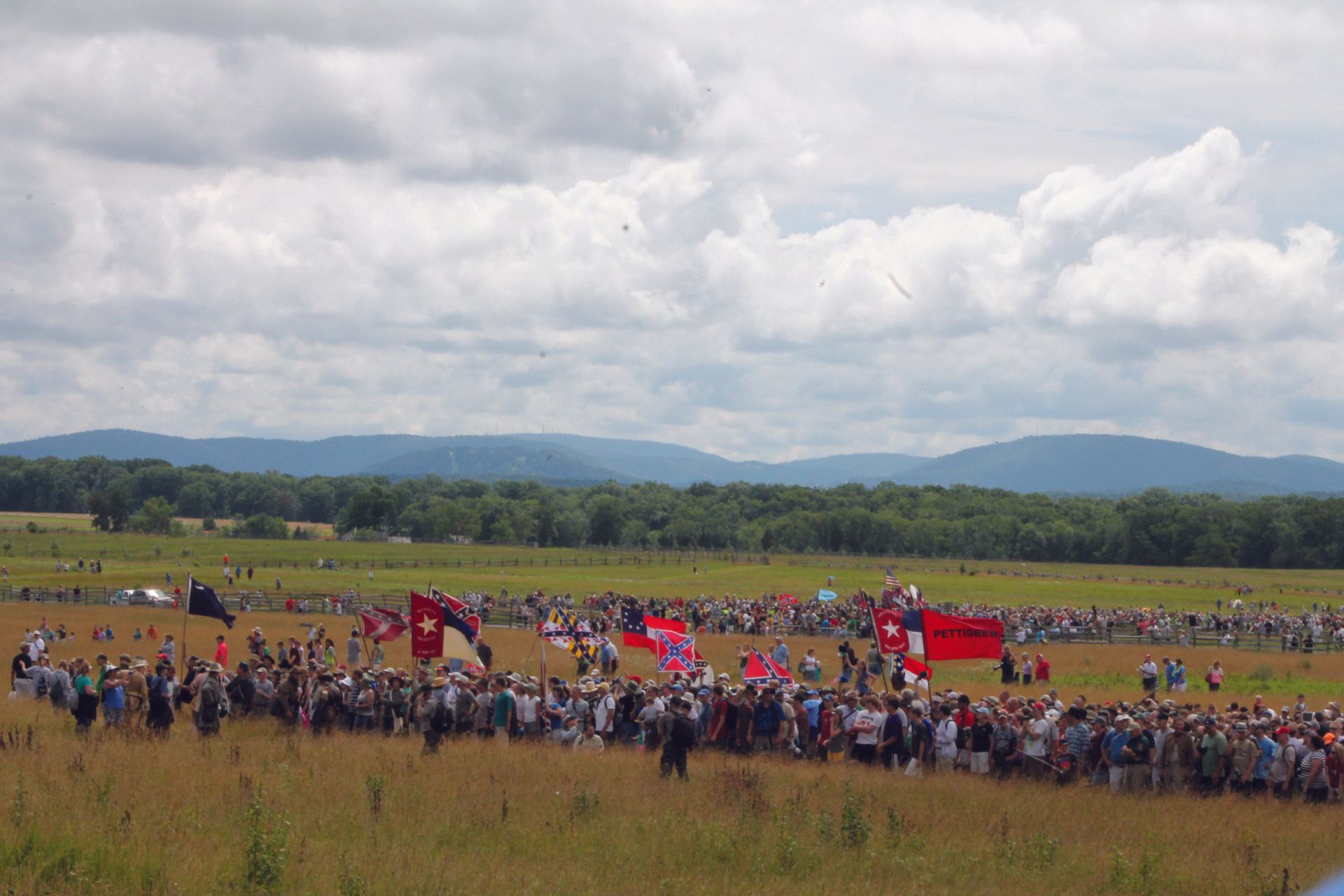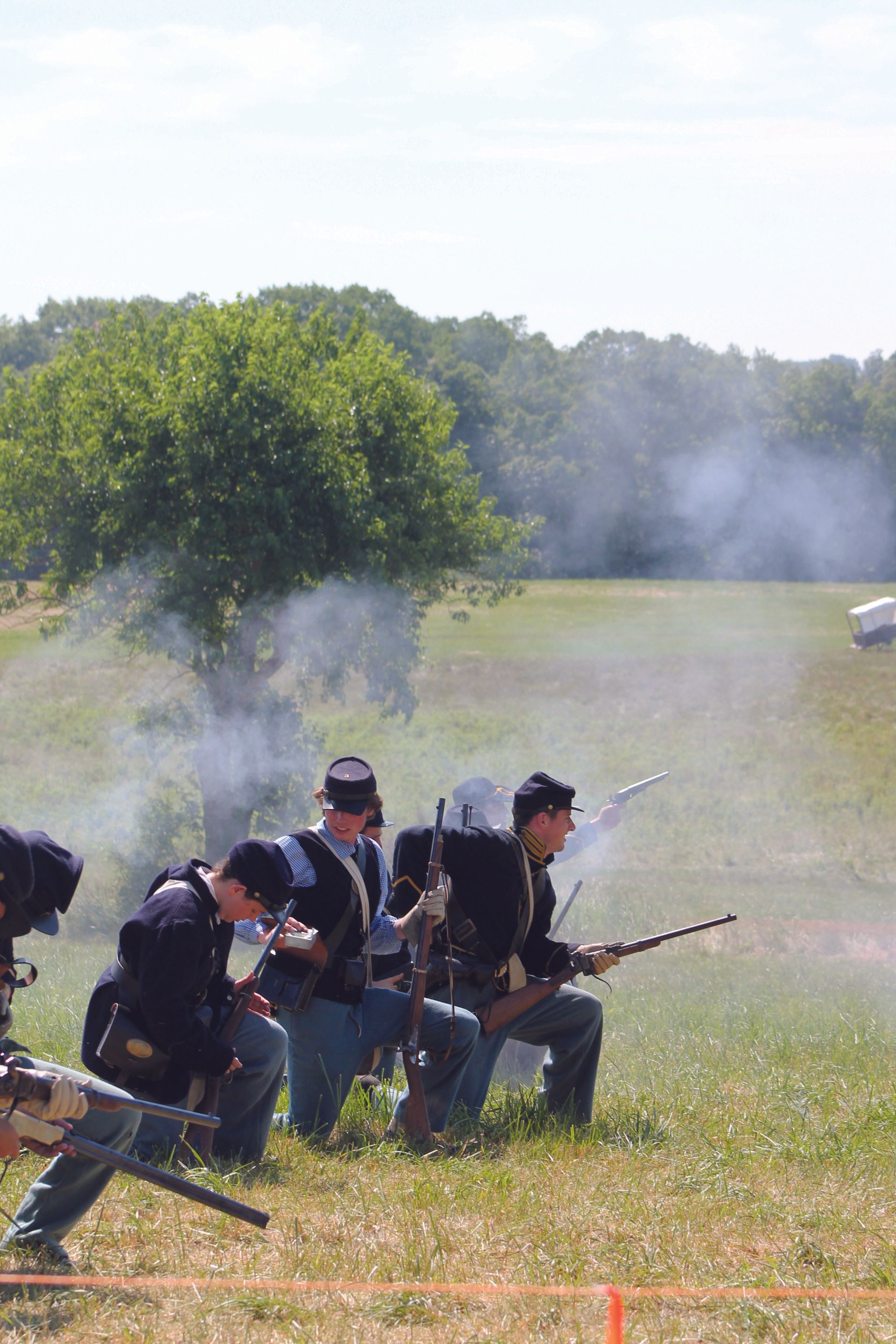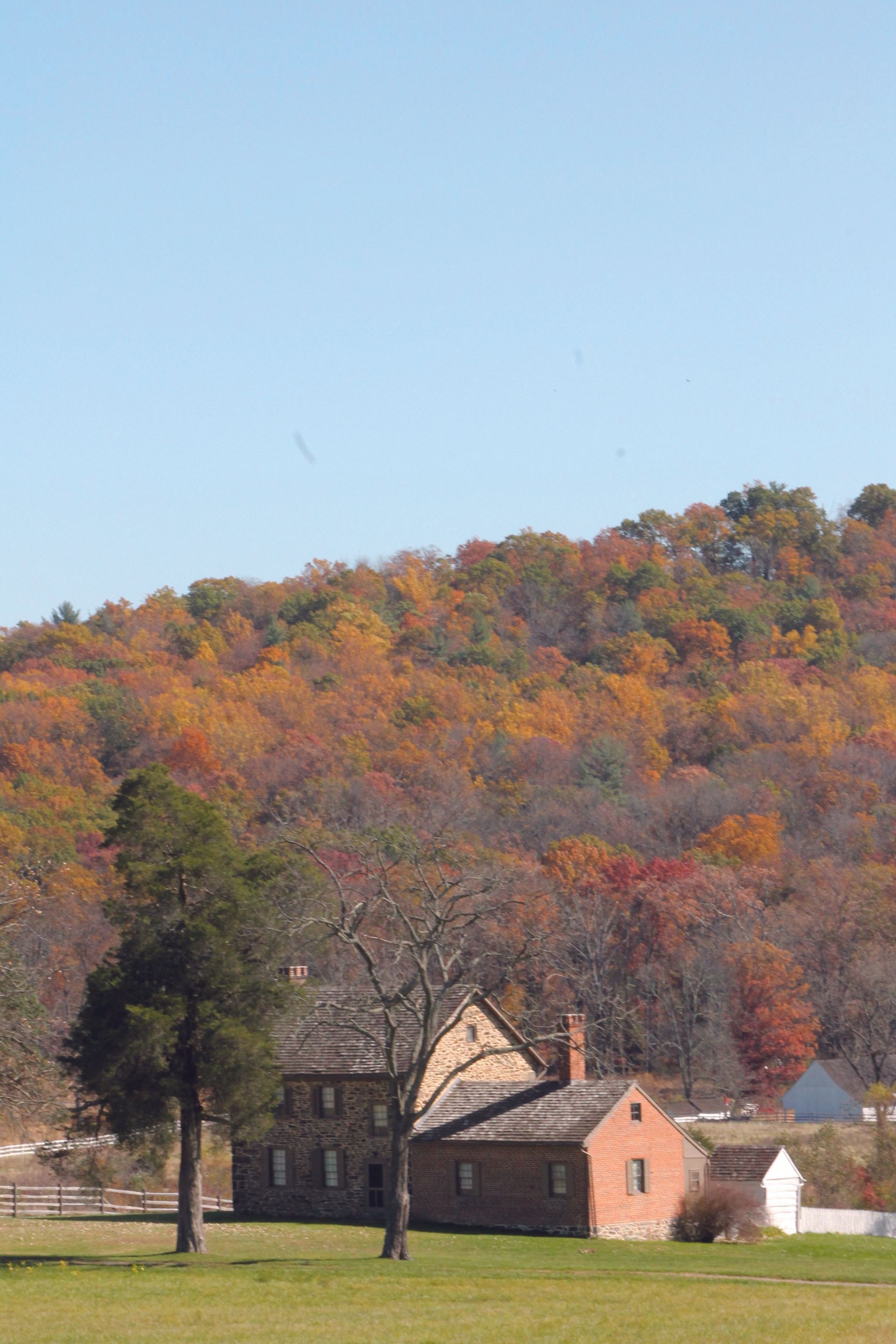25 Years of Experience
by Diana Loski

Author Photos
The Gettysburg Experience celebrates its silver anniversary with this issue. It’s hard to fathom a quarter century of monthly publications. It was suggested to us to fill in our readers – many of whom have been reading our magazine for 25 years – about how the magazine began and some of the experience we accumulated across the years.
We came to Gettysburg in 1995. One of us was a newly published writer with a degree in education and an interest in history, the other had a degree in business who wanted to have his own company. Since we have Civil War ancestors, there was always an interest in that period of history. We never dreamed of starting a magazine. For one thing, we had no idea how to do it.
One day, George Lower, the owner of Lord Nelson’s Gallery in Gettysburg, told Leonard, my husband, that the local business owners needed a voice to attract the countless visitors who come to town. “You’re an entrepreneur,” George told him. “Your wife is a writer. Start a magazine.”
Writer and business owner Mark Nesbitt agreed. “Make it interesting,” he said to me. “And make it free.”
We were a young family, with four children, a dog, and a cat. Our youngest was about to start kindergarten. I agreed to teach school, since I had that degree, so that my husband could be free to start the magazine. And I told him I would write a few articles each month.
We bought a computer. We had no idea how to work it. Leonard hired Stephanie, our first graphic artist, to work as an outside contractor – we had no idea if we needed someone full time, part time, or hardly any time. We bought a computer program for what we were told would provide a template for laying out a magazine. It turned out to be for books. With our first edition, the ads overloaded the program with their volume of data. At 2 a.m. on the day we were supposed to go to press for the first time, the computer crashed. On the desktop was a cannonball and the words “all or most of data may be lost”.
It didn’t appear to be an auspicious beginning!
Through migraine-induced fog, we took the computer to Sunrise Computers in Chambersburg, and after several hours they miraculously brought back the data. They also informed us that we had the wrong program. We purchased the right one and went ahead.
We had decided right away that we needed to make the magazine good enough that people would be willing to pay for it to read it – then make it free of charge. The advertisements would pay for all the pre-press, publication and printing costs, and our salaries. For a quarter of a century, it has worked. Even through the Covid shut down we managed to stay in business.
Some of our advertisers have been with us from the beginning. We have seen many businesses come and go – and within the pages of the magazine is a microcosm of history with some of the businesses who were here, those who remain, and those who are new additions to town.
I came up with the idea for Trivia Questions. Leonard said we needed to ensure that every page is seen for the sake of the advertisers, and that was our answer. We knew we needed a map of the town, so visitors could find their way. Our graphic artist made one.
Through the early years, readers and advertisers gave us suggestions. We needed a Letter from the Editor. We needed to put “continued” on the bottom right pages of articles. We needed a Battlefield Map. And we thought old-fashioned recipes were a nice touch, too. My grandmother and a maiden great-aunt were both prolific cooks; when they passed away, I received most of their recipes. I also received from my aunt an old edition of the White House Cook Book from the year 1887.
We decided to print the magazine on non-glossy paper. Not only is it less expensive to produce, it is environmentally friendly, and takes less time to process.
Leonard came up with the “Priceless” on the cover. Like Mark Nesbitt advised us, we needed the magazine to be free for anyone who wanted one, but when something is free of charge it implies that it is cheap. And we are not cheap. Hence, “Priceless” was the answer.
It’s always tricky to get everything to fit. Since the magazine comes in 4-page increments, we have to either move up a page or two or down a bit to make everything fit. From time to time, a new advertiser might come in late and we always try to accommodate them. (Once the magazine is laid out, it’s nearly impossible to make it work.) Once, I removed the Battlefield Map, and found out that was not appreciated! On another occasion, I removed the recipes, and was reprimanded for that, too.
When we started the publication, another hurdle came in the form of Pennsylvania State Law with educators. I had lived for many years in the west, and had not taught school for seven years because we had four little children. The local school board told me I would have to go back to school to take a few classes, then student teach again.
Nope.
I learned that the National Park Service was giving the guide exam later that year. After months of intense study and preparation, I took it and passed. It has made all the difference for the hundreds of articles that would appear in the magazine over the years. The licensed battlefield guides have always been a tremendous help in offering ideas and critiques, and so many of them were (and are) historic treasures.
We met local legends like Colonel Jacob M. Sheads – a war veteran, history teacher, park ranger, and the guide who took President and Mrs. Kennedy over the battlefield six months before Kennedy’s assassination. We knew Bob Mullins – the guide who documented that JFK’s tomb was fashioned after our Eternal Light Peace Memorial. And I will never forget Bob MacAskill – the pastor of the Gettysburg Presbyterian Church who officiated at President Eisenhower’s burial in Kansas.
Colonel Sheads took us on his personal tour of the battlefield in the early days of our publication. His grandparents had lived on Carlisle Street during the battle in 1863. “My grandparents hid in their cellar for three days,” he told us, “and they were scared to death.” He was proud of the fact that his birth year in 1910 coincided with the dedication of the Pennsylvania Memorial. Sheads shared many personal stories of his years as a guide. An avowed Unionist, he once took a couple around the battlefield, noticing that their car had New York plates. Thinking they were Union people like he was, when they stopped at the Virginia Memorial on Seminary Ridge, they paused to see General Lee atop the monument. Sheads remarked how Robert E. Lee was a traitor to his country. The couple politely asked him to step out of their car. They then drove away, leaving him stranded. They were from Virginia, and their car was rented. He walked all the way back to the Visitor Center, lesson learned.
Bob Mullins told me (and others) how he spoke with Jack Valenti, the head of President Lyndon B. Johnson’s public relations team in 1963. He said the new President asked Valenti to speak with Jackie Kennedy on her wishes for JFK’s memorial at Arlington. “I want a peace light,” she simply said to Valenti. Bob Mullins recounted that Valenti replied, “What the h--- is a peace light?” Mrs. Kennedy told him to go to Gettysburg and see it. And he did.
It’s interesting that Arlington, the home of Robert E. Lee, was also the burial place of our 35th President – whose Boston Irish ancestors fought for the Union. The Gettysburg connection ties them together with an eternal flame.
Bob MacAskill and I often conversed in the guide room. He told me that Ike (one of his parishioners) often talked with him about the Battle of Gettysburg. Bob related that once Ike took General Bernard Montgomery around the battlefield. The two spoke of the high casualties incurred by both Meade’s and Lee’s armies. Ike told MacAskill that “Monty and I decided that if we had lost the number of men that Lee and Meade had lost at Gettysburg, we would have been relieved of command.”
Bob MacAskill was the pastor who traveled to Kansas and officiated at President Eisenhower’s burial in Abilene. Three Presidents attended that service: Lyndon Johnson, Harry Truman, and Richard Nixon.
These great historians are now gone. The historic people they knew are gone. We are so grateful to have known them, and to have learned from them.
In addition to the guides, we met the last surviving pilot of the Doolittle Raiders, Dick Cole, who lived to be 103. We saw him at age 102, and he was still as sharp and gracious as ever. We knew the renowned Ed Bearss, who served for many years as the Chief Historian of the National Park Service. At age 85 he could outwalk anyone half his age on any battlefield. When interviewed by a national magazine at age 90, he was asked if he could only visit one battlefield, which one would he choose? He answered Gettysburg, without hesitation.
We met a few of the heroes from the 101st Airborne who were featured in the film Band of Brothers. We met many who fought in significant battles, from D-Day to the Ardennes, from Guadalcanal to Iwo Jima. One of the renowned veterans who led the first tanks over the Remagen Bridge, C. Windsor Miller, lived in Adams County for a time. He vividly recalled the tense moments over the bridge, not knowing if it would hold.
Not all veterans could share their memories. One slow day in the guide room, I remember talking with Hans Henzel, who had fought on Iwo Jima. I happened to be reading Flags of Our Fathers at the time, and asked Hans if he had read it. He had. I asked him to tell me about his experiences in that great battle. He opened his mouth in an attempt to tell me, then tears welled up; he clammed up and gently shook his head. “I can’t,” he said. “Just read the book.”
Reading books and manuscripts (and old letters and diaries) is what I do. Writers are always readers first. I have spent so much time in the Gettysburg National Park Library and the Adams County Historical Society that the directors, chief historians, and volunteers have become good friends. Whenever we go out of town, I visit the local historical societies wherever we go – from Maine to South Carolina, to the town of Gettysburg in South Dakota to the states of Washington and California. I’ve also researched overseas. Just about everywhere we find a Gettysburg connection.
Did you know that Colonel John Lane, the commander of the Florida Brigade at Gettysburg, is buried in a cemetery in Lewiston, Idaho, close to the banks of the Snake River? His tombstone reads “One of Lee’s Men.” Did you know that in Ireland, on the outer walls of Bunratty Castle, there is a plaque that reads “William Penn, as a baby, was here during a siege against Cromwell’s army.” Penn is buried in a simple grave in the village of Jordan’s, near Oxford, in England. He wanted to come back to his colony, but ill health and debtor’s prison prevented him.
In France, most people spend the bulk of their time in Paris or The Riviera. (And who can blame them?) We instead visited National Cemeteries. Since Gettysburg is the first of the American National Cemeteries, it was essential to us to see how the honorable idea begun by Gettysburg attorney David Wills has advanced. Since World War I and World War II battlefield tours are so costly, we just rented a car and drove to all the cemeteries and battlefields by ourselves. It was one of the most profound experiences we have had.
As the years have passed, and our work for the magazine multiplied, I could no longer remain a licensed guide while continuing with the magazine and raising a family. The workload was just too much. I reluctantly turned in my guide badge (#144) in 2007 after ten years of guiding.
Tracy Wardecker is our graphic artist, and she is like family. She has been with us for ten years. Ed Shetter, a veteran of the Navy who has lived in Gettysburg with his wife of over fifty years, is our delivery person. He is a tremendous help. Before Ed came along, we made our children help us deliver the magazines. They did not like it, and they made sure to get degrees for professions that have nothing to do with publishing or advertising. They all love Gettysburg though, and often come to visit. When they do, we make sure to take a trip to the battlefield.
Two books have come out of the magazine, and one is still in print. It is titled A Gettysburg Collection. It is just what it claims to be: a collection of some of the articles from the magazine in a more permanent form.
A few years ago, we decided to add the Editor’s Corner in the back of the magazine. I have noticed too many incorrect spellings on signs, bad grammar in books, and mispronounced words uttered on television by people who should know better. The inner English teacher in me was thoroughly irked by it. Finally, I decided to write the Editor’s Corner, hoping that it wouldn’t offend the readers. To my great surprise, people seem to love it. The piece has branched out a bit to include the history of some of our vernacular (like French words, Latin words, Nautical Terms we use in our every-day speech, etc.) to Fancy Words (like pendeloque – the central gem in a pendant) to Editorials (like how many died at Gettysburg – the impossible question with no definite answer).
My husband handles the business side of running the magazine and I handle everything that is not an advertisement. That includes all the photos (including the cover photo), updating the Calendar of Events, being responsible for all the articles – most of them written by me, (although we do accept other writers from time to time), and editing it all before going to press.
We try to ensure that every advertiser gets fair treatment. While some pay extra to stay in a certain place, most of our advertisers are moved from month to month. The ads that are in or near the back one month are moved to the front the following month. Parenting has taught us to be sure to be fair and equal! (Still, the back can be a good place too. The Trivia Answers are there, for one thing.)
We frequent the businesses who advertise. We go on the tours, eat in the restaurants, shop at the shops, and visit the museums. We want them to stay in business, not just for our sake, but for Gettysburg’s sake. The businesses make Gettysburg what it is, what it has always been, historically, as a crossroads town.
Gettysburg is such a unique town. It is so well preserved, and such a lovely place. It has amazingly preserved its history, yet is vibrantly part of today. We love it.
In my research, I frequently find a mixed feeling among the soldiers who fought here in 1863. Most of them relished returning to Gettysburg, and came to the reunions – including get-togethers not as well known to history. Some of them never returned – they never wanted to. The memories were too difficult. The sudden, tragic loss of loved ones, of comrades, seeing death and destruction to such a terrible degree were just too awful to contemplate. Some were able to move past it, and some decided to never let Gettysburg – or any battle – encroach upon their memories ever again. For those who wrote about their experiences – and they are many – I have greatly appreciated their words. Some of them are filled with humor. Some are so terribly sad that it is difficult to read them. I have wept many times in the libraries and historical societies. Their chronicles are sometimes overpowering.
As we pass our anniversary, we wanted to thank everyone who had made these past 25 years possible, especially our readers, who have been part of the journey. History is essential to remember so that we don’t repeat the mistakes. As Cicero said, back in the days of Julius Caesar, “If you do not know what came before you were born, you are to remain always a child.”
Lincoln said it best right here in Gettysburg, “The world… can never forget what they did here.”
Not only will we never forget, we must not forget.
With over 160,000 soldiers, 2400 civilians and two Presidents so inseparably connected to Gettysburg, I will never run out of material.



